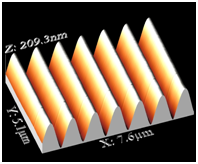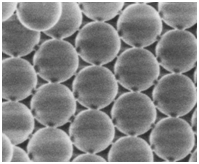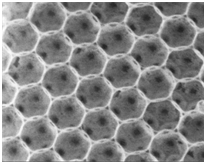Advanced Materials Synthesis Group
Research topics conducted in the Advanced Materials Synthesis Group are related to the design and synthesis of inorganic (phosphors, metallic or oxide nanoparticles) and organic compounds with designed physicochemical characteristic, including luminescent, thermochromic, thermal, mechanical as well as antibacterial, electrical or sensing properties. The group is working on hybrids systems modified and / or doped dyes and nanoparticles for use in photonics and to obtain laser action. Biodegradable polymer and composite materials with functional properties are also developed. An example are the intelligent transport systems of active substances for applications in medicine and cosmetology. The research is also focused on solid state chemistry and processes occurring on the solid and gaseous/liquid phase interfaces. Within the scope are adsorption and catalysis using porous materials, such as layered aluminosilicates and layered double hydroxides, their modification and application in elimination of hazardous substances from air and water. Additionally, the studies on modification of different materials by focused electron beam are conducted in order to achieve desired physicochemical properties for potential application in photonics and electronics. These studies particularly involve micro- and nanostructuring of ionic liquids and their mixtures with other compounds (e.g. metal salts).
Dr. Sc. Eng. Alicja Bachmatiuk (Project Leader)
Dr. Sc. Joanna Cybińska, Head of ADMAT research group
A graduate of master studies in the field of Environmental Chemistry at the Faculty of Chemistry
of University of Wrocław. Scientific career: M.Sc. 2000, Ph.D. 2006, D.Sc. 2016. She is the co-author
of 79 publications (IF = 250) and 7 book chapters (index h = 22). She completed numerous internships abroad: postdoctoral researcher at LPCML (since 2012 iLM) at the Claude Bernard University in Lyon in France (2008-2009), since 2010 she returns to iLM regularly 3-4 times a year to perform spectroscopic measurements. She spent 3 months at iLM in the frame of the BGF scholarship of the French government (2012, 2014, 2015) and recently the annual scholarship from NAWA (2021-2022).
Moreover, she completed several internships at the Shanghai Institute of Optics and Fine Mechanics (SIOM), CAS, China (2013, 2014, 2019). She was PI in 5 international projects: NCN-HARMONIA, MNiSW, NAWA-POLONIUM, she was also an investigator in 7 national and international projects. Laureate of the scholarship of M. Bekker (NAWA-2020 edition). She was also involved in organizational and editorial activities: Editor in Optical Materials (10 years), Guest Editor of many volumes; co-chair, secretary and co-organizer of many international conferences. Chair of the IS-OM8 conference (2019). Her research interests include fabrication as well as structural and spectroscopic characteristics of rare earth activated inorganic optical materials in the form of nano/ micro-powders, single crystals, transparent sintered ceramic, glasses and optical fibers, for application as phosphors, laser materials or scintillators.
Since 2020 she has been associated with the Łukasiewicz Research Network – PORT Polish Center
for Technology Development, where she is the head of the research group at PORT implementing
the project HYPHa.
https://orcid.org/0000-0001-8753-7529
https://www.researchgate.net/profile/Joanna-Cybinska-2
Dr. Sc. Małgorzata Guzik (Team leader at PORT)
A graduate of master studies in the field of Environmental Chemistry at the Faculty of Chemistry
of University of Wrocław. Scientific career: M.Sc. 2000, Ph.D. 2006, D.Sc. 2016. She is the co-author
of 79 publications (IF = 250) and 7 book chapters (index h = 22). She completed numerous internships abroad: postdoctoral researcher at LPCML (since 2012 iLM) at the Claude Bernard University in Lyon in France (2008-2009), since 2010 she returns to iLM regularly 3-4 times a year to perform spectroscopic measurements. She spent 3 months at iLM in the frame of the BGF scholarship of the French government (2012, 2014, 2015) and recently the annual scholarship from NAWA (2021-2022).
Moreover, she completed several internships at the Shanghai Institute of Optics and Fine Mechanics (SIOM), CAS, China (2013, 2014, 2019). She was PI in 5 international projects: NCN-HARMONIA, MNiSW, NAWA-POLONIUM, she was also an investigator in 7 national and international projects. Laureate of the scholarship of M. Bekker (NAWA-2020 edition). She was also involved in organizational and editorial activities: Editor in Optical Materials (10 years), Guest Editor of many volumes; co-chair, secretary and co-organizer of many international conferences. Chair of the IS-OM8 conference (2019). Her research interests include fabrication as well as structural and spectroscopic characteristics of rare earth activated inorganic optical materials in the form of nano/ micro-powders, single crystals, transparent sintered ceramic, glasses and optical fibers, for application as phosphors, laser materials or scintillators.
Since 2020 she has been associated with the Łukasiewicz Research Network – PORT Polish Center
for Technology Development, where she is the head of the research group at PORT implementing
the project HYPHa.
https://orcid.org/0000-0002-5963-6316
https://www.researchgate.net/profile/Malgorzata-Guzik
Dr. Eng. Maciej Czajkowski
He was graduated (MSc) in Chemistry in 2009 and obtained PhD degree in 2014 at the Faculty of Chemistry, Wrocław University of Technology. He participated in 9 research projects financed by the NCN, NCBR, FNP and POIG, including managing of the project under the NCN SONATA 11 grant entitled ”Wytwarzanie i charakterystyka nowych materiałów ciekłokrystalicznych zawierających chiralne związki jonowe do zastosowania w modulatorach światła” (“Fabrication and characterization of new liquid crystal materials containing chiral ionic compounds for application in light modulators”), and currently he is managing the project under the NCBiR LIDER XII grant entitled „Zastosowanie kryształów fotonicznych w zabezpieczeniach oryginalności” (“Application of photonic crystals in originality protections”). He is a co-author of 20 scientific publications (number of citations according to Scopus: 72, index h = 6) and one patent.
Since November 2013, he has been working at the Łukasiewicz Research Network – PORT Polish Center for Technology Development (previously: Wrocław Research Center EIT +). Since June 2020, he has been working as the Chief Specialist in the Research Group of Synthesis of Advanced Materials. His main research interest is engineering of materials photonics applications, including: liquid crystal materials, photonic crystals, dyes, polymers, ionic liquids, holographic and thermochromic materials.
https://orcid.org/0000-0002-4573-461X
https://www.researchgate.net/profile/Maciej-Czajkowski
Dr. Eng. Marta Fiedot-Toboła
She holds a bachelor’s degree (2012) and a master’s degree (2013) in materials engineering, specializing in polymer engineering and technology, from the Faculty of Chemistry at Wrocław University of Science and Technology. She then completed doctoral studies in automation, electronics, and electrical engineering at the Faculty of Microsystem Electronics and Photonics at the same University (2019). She has been the leader of 4 and a participant in 8 research projects. She is a co-author of 31 scientific publications (citations according to Scopus: 270, h-index=10), 6 patents, and 5 patent applications.
Since 2019, she has been working at the Łukasiewicz Research Network – PORT Polish Center for Technology Development. Initially, she was employed in the Polymer Materials Laboratory as a Research Engineer, and since 2021, she has held the position of Senior Specialist in the Advanced Materials Synthesis Research Team. Her work involves the production and modification of polymers and polymer composites with functional properties. These materials are primarily based on inorganic nanoparticles and biodegradable natural polymers. Examples include smart systems for the transport of active substances for applications in medicine and cosmetology.
https://orcid.org/0000-0001-7094-7003
https://www.researchgate.net/profile/Marta-Fiedot-Tobola
Dr. Eng. Bartłomiej Potaniec
He was awarded the degree of doctor in natural sciences in the field of biological in 2019 at the Faculty of Biotechnology and Food Sciences at Wrocław University of Environmental and Life Sciences. He participated in 7 research projects financed by the National Science Center, National Center for Research and the Foundation for Polish Science. He is a co-author of 17 scientific publications (number of citations according to Web of Science: 100, h index =7, IF> 50), 3 chapters in post-conference monographs and 20 national patents.
Since April 2017, he has been working at Łukasiewicz-PORT and since June 2021 he has been holding the position of Senior Specialist at the AdMat Group. His scientific research focuses on the synthesis of compounds from the groups of flavonoids and chalcones exhibiting biological properties (antioxidant and anti-cancer) and the synthesis of compounds with specific luminescent and thermal resistance properties.
https://orcid.org/0000-0001-5657-4861
https://www.researchgate.net/profile/Bartlomiej-Potaniec
Dr. Eng. Krzysztof Rola
He is a graduate of master studies (2009) in the field of Electronics and Telecommunication, specialization: Microsystems, at the Faculty of Microsystem Electronics and Photonics of the Wrocław University of Science and Technology, where he also received his PhD in Electronics in 2015.
He has participated in 6 research projects financed by NCN, FNP, NCBR. He is a co-author of 27 research papers (number of citations according to Web of Science: 234, Hirsch index: 9) and 2 patent applications. In 2015-2017, he worked as a Specialist at the Institute of Low Temperature and Structure Research, PAS. Since 2017, he has been working at the Łukasiewicz Research Network – PORT Polish Center for Technology Development (previously: Wrocław Research Centre EIT+), and since 2021 he has been a Senior Specialist in the Advanced Materials Synthesis Research Group. His current research interests include micro- and nanostructuring of different materials using electron and ion beams as well as application of ionic liquids in micro- and nanotechnologies.
In the HYPHa project, he is responsible for fabricating optical gratings using nanoimprint and electron beam lithography. In addition, he handles the SEM/FIB/EDS microscopic examinations, as well as he coordinates the work on fabrication of waveguides by means of photolithography, etching and nanoimprint.
https://orcid.org/0000-0002-8404-4806
Dr. Jean-Guy Rousset
He earned his PhD at the University of Warsaw in 2017. His research focuses on group III-V, II-VI semiconductors, nitrides (III-N), and their doping with magnetic ions—diluted magnetic semiconductors (DMS). His approach includes designing structures, creating them through epitaxial growth methods (MBE, MOVPE), and conducting in-depth studies of their properties using electron microscopy, optical spectroscopy, and magneto-optical techniques. He has participated in 10 research projects (including 1 ERC and 3 as Principal Investigator). He is the co-author of over 30 scientific articles, including 4 in journals from the Nature group (citation count according to Web of Science: 238, h-index: 7), and has given over 10 presentations at international conferences.
Since 2018, he has been working at the Łukasiewicz Research Network – PORT Polish Center for Technology Development. He is currently leading the “Van der GaN” project funded by the Łukasiewicz Research Network.
Dr. Wojciech Stawiński
A graduate of the Faculty of Chemistry at Jagiellonian University, he earned his PhD in the field of chemical sciences from the University of Porto in Portugal and the University of Lisbon in 2017. During his PhD and postdoctoral studies, he worked in the GRAQ/LAQV laboratory (REQUIMTE) at the Polytechnic Institute of Porto, where he developed applications for modified aluminosilicates in water treatment processes. He has led 4 research projects in collaboration with the industry and participated in 2 projects funded by public resources. He is the supervisor of 2 industrial PhD programs conducted at the Łukasiewicz Research Network – PORT Polish Center for Technology Development. His scientific output includes 12 publications in international journals (citation count according to Scopus: 288, h-index: 8), and 5 book chapters related to environmental protection published by renowned academic publishers.
Since 2018, he has been working at Łukasiewicz – PORT as a senior specialist in the Advanced Materials Synthesis Research Team. His work focuses on two areas: the synthesis and physicochemical characterization of functional materials based on aluminosilicates for water and air purification, and the production of composites based on biodegradable polymers for applications in the food and cosmetics industries.
https://orcid.org/0000-0002-1421-0741
https://www.researchgate.net/profile/Wojciech-Stawinski
Dr. Eng. Magdalena Wilk-Kozubek
She holds a master’s degree (2009) and a PhD (2016) in Chemistry from the Faculty of Chemistry at Wrocław University of Science and Technology. Between 2016 and 2019, she completed two postdoctoral fellowships at Iowa State University in the USA and Stockholm University in Sweden, working in the group of Professor Anja-Verena Mudring. She has participated in seven research projects both in Poland and abroad, acting as the principal investigator in two of them. She is the co-author of 19 scientific publications (citation count according to Web of Science: 109, h-index: 6) and two patents.
Since 2014, she has been working at the Łukasiewicz Research Network – PORT Polish Center for Technology Development (formerly Wrocław Research Center EIT+), and since 2021, she has held the position of senior specialist in the Advanced Materials Synthesis Research Team. Her scientific interests focus on the synthesis and characterization of materials with luminescent and thermochromic properties. She is currently leading a project aimed at developing thermochromic paint designed for marking frozen food packaging. The project is funded by the National Center for Research and Development as part of the 11th edition of the Lider Program.
https://orcid.org/0000-0002-1730-0304
https://www.researchgate.net/profile/Magdalena-Wilk-Kozubek
Dr. Eng. Krzysztof Lis
He holds both a bachelor’s and a master’s degree in Chemical Technology from the Faculty of Chemistry at Wrocław University of Science and Technology. He is currently a PhD candidate at the Doctoral School of Wrocław University of Science and Technology, where he is partially conducting his research under the Industrial Doctorate program. He is the co-author of one scientific publication in a journal listed in the Philadelphia List, and his research findings have been presented at international conferences and published in industry journals.
Since July 2018, he has been working at the Łukasiewicz Research Network – PORT Polish Center for Technology Development as a Senior Research Engineer. As part of his PhD studies, he focuses on the synthesis and investigation of the properties of two-dimensional materials for electronic applications, with a particular emphasis on the anti-corrosive and electrical properties of graphene coatings. Additionally, he is leading a project aimed at conducting innovative processes for the production and regeneration of activated carbons using microwave methods.
M.Sc. Eng. Andrii Bodnar
He holds a master’s degree in Electrical Engineering, specializing in Control Systems for Power Engineering Processes (2002), from the Faculty of Electrical Power Engineering and Automation at Kyiv Polytechnic Institute, and a master’s degree in Physics, specializing in Quantum Engineering (2021), from the Faculty of Fundamental Problems of Technology at Wrocław University of Science and Technology. Since 2020, he has been pursuing doctoral studies in the field of physical sciences at the Doctoral School of Wrocław University of Science and Technology.
Since October 2020, he has been working at the Łukasiewicz Research Network – PORT Polish Center for Technology Development (formerly Wrocław Research Center EIT+) in the Advanced Materials Synthesis Research Team. His scientific research focuses on creating electrical contacts for Van der Waals crystals.
https://orcid.org/0000-0002-9682-7939
https://www.researchgate.net/profile/Andrzej_Bodnar2
Dr. Maria Zdończyk
She holds a master’s degree in Chemistry, specializing in Materials Chemistry for Modern Technologies (2020), from the Faculty of Chemistry at the University of Wrocław. She is currently pursuing a PhD in the field of exact and natural sciences, specifically in chemical sciences, at the Faculty of Chemistry at the University of Wrocław as part of the Implementation Doctorate program. She has participated in the execution of 5 research projects funded by the National Science Centre (NCN), the National Centre for Research and Development (NCBR), and the Foundation for Polish Science (FNP).
She is a recipient of the Minister’s Scholarship for students with significant scientific achievements. She has co-authored 2 scientific publications. Since 2018, she has been part of the Advanced Materials Synthesis Group at the Łukasiewicz Research Network – PORT Polish Center for Technology Development, and since October 2020, she has held the position of Assistant for Scientific and Technical Affairs – Junior Specialist. Her scientific research focuses on luminescent active layers for photonics applications based on doped sol-gel materials, as well as the synthesis of compounds and materials with specific luminescent properties.
https://orcid.org/0000-0002-2064-0377
M.Sc. Jakub Pawłów
A graduate of master’s studies in the field of Medical Chemistry at the Faculty of Chemistry of University of Wrocław (2021). He was investigator in 6 national and international research projects financed by NCN, NCBiR i FNP. He is a co-author of 1 scientific publication in the Master Journal List, the research results have been presented during many national and international conferences. During one of them, on VI Szczecin Symposium for Young Chemists, he was awarded for the best oral presentation. Twice (2021, 2022) he completed a two-week research internship at the iLM laboratory at the Claude Bernard University in Lyon, France. At present, he is a PhD student at the Doctoral College of Chemistry at the University of Wrocław, where, in cooperation with the Łukasiewicz Research Network – PORT Polish Center for Technology Development carries out research as a part of Implementation Doctorate program. The research concerns the development of a hybrid optical temperature sensor based on both inorganic and organic compounds. In 2016, he was an intern at Łukasiewicz-PORT, and since 2021 he has been a Junior Specialist in the Advanced Materials Synthesis Research Group. The main area of research conducted by him is the synthesis of inorganic luminescent materials doped with rare earth elements and their structural and spectroscopic analysis. In the HYPHa project, he deals with surface structuring using an ion beam.
https://orcid.org/0000-0001-8369-3719
https://www.researchgate.net/profile/Jakub-Pawlow
Sc. Kacper Albin Prokop
A graduate of master’s studies in the field of Medical Chemistry at the Faculty of Chemistry of University of Wrocław (2021). Laureate of the National Competition “Student Nobel 2021” organized by the Independent Students’ Association in the category of Life Sciences and Energy. Finalist of the “Gold Medal of Chemistry” organized by the Institute of Physical Chemistry of the Polish Academy of Sciences for the best bachelor thesis in the field of chemistry (2019). He was investigator in 4 national projects and international research projects financed by NCN, NCBiR and FNP, at present he is investigator in 3 projects. He is a co-author of 3 scientific publications and presented the results of his research at several international and national conferences. During one of them he received an award for a poster presentation – Jury Congratulations – 8th International Workshop on Photoluminescence in Rear Earths: Photonic Materials and Devices (PREʹ19), Nice, France. Twice (2021, 2022) he completed a two-week research internship at the iLM laboratory at the Claude Bernard University in Lyon, France.
Currently, he is realizing his PhD studies as a part of the Implementation Doctorate program at the Faculty of Chemistry, University of Wroclaw and Łukasiewicz Research Network – PORT Polish Center for Technology Development.
The aim of conducted research is selecting new inorganic matrices with cubic structure and carrying out attempts to fabricate of ceramic materials with high transparency, which, after activation with rare earth ions, can be used as efficient optical materials.
With Łukasiewicz-PORT He has been associated since 2016, when he completed an internship as a student, and from 2021 he holds the position of a Junior Specialist in the Advanced Materials Synthesis Research Team. His research interests are focused on the synthesis and structural and spectroscopic studies of f-electron activated (mainly Eu3+, Nd3+ and Yb3+) inorganic compounds from the group of phosphates and tungstates in the form of nano and micro-powders. In the HYPHa project, he deals with surface structuring using an ion beam.
https://www.researchgate.net/profile/Kacper-Prokop
https://orcid.org/0000-0002-8316-3985
Sc. Eng. Łukasz Duda
He is a graduate of engineering and master’s studies in the field of Materials Science with specialization in Advanced Functional Materials, from the Faculty of Chemistry of the Wrocław University of Technology. Currently, he is a PhD student at the Doctoral College of Chemistry at the University of Wrocław, where, in cooperation with the Łukasiewicz Research Network – PORT Polish Center for Technology Development carries out research in the frame of Implementation Doctorate program.
He is a co-author of 5 scientific publications. He participated in 5 projects financed by the NCN, FNP and NCBR. Since November 2020, he has been working at the Łukasiewicz Research Network – PORT Polish Center for Technology Development as a Junior Specialist in the Advanced Materials Synthesis Group. As part of his doctorate, he is working with of organic dyes for applications in photonics. His scientific interests are mainly focused on the fabrication of materials with controlled refractive index (for use as waveguiding films) and their characterization, fabrication and characterization of liquid crystal materials and characterization of the luminescent properties of organic dyes in different matrices (liquid crystalline, polymer and sol-gel).
https://orcid.org/0000-0002-4184-1266
https://www.researchgate.net/profile/Lukasz-Duda-2
Prof. Dr. Sc. Eng. Robert Kudrawiec
A graduate of the Faculty of Fundamental Problems of Technology at the Wrocław University
of Technology, specializing in solid state physics. Scientific career: M.Sc. 2000, Ph.D. 2004, D.Sc. 2010, Prof. 2018. International internships: February 2006 – May 2007 post-doc at Stanford University, January 2012 – September 2013 sabbatical at Lawrence Berkeley National Laboratory.
Since October 2017, he is associated with PORT, where he is currently the leader of the EpiMat research group. He specializes in optical semiconductors for their applications in semiconductor devices. These are group III-V semiconductors, including group three nitrides, group IV and II-VI semiconductors, and recently these are van der Waals crystals and perovskites. In the HYPHa project, he deals with van der Waals crystals and their integration with silica-based waveguides.
https://orcid.org/0000-0003-2593-9172
https://www.researchgate.net/profile/Robert-Kudrawiec
Dr. Eng. Sandeep Gorantla
A PhD graduate from Technische Universität Dresden (TUD) with specialization in Materials Science and Engineering in the field of Transmission Electron Microscopy of carbon nanostructures and materials research. Scientific career: Author of about 56 peer-reviewed scientific publications (h index=20) and book chapters 1. He has been working with a variety of material systems including oxides, thin-films, nanoparticles/nanowires, 1-D carbon nanostructures, graphene and possess extended expertise in using various TEM sample preparation and TEM techniques. He worked as TEM postdoc at IFW-Dresden, McMaster University, University of Oslo and Lukasiewicz Network PORT during the past years. He was PI of NCN individual project Polonez-1 during 2017-2018 and currently working of Norway grants-NCN bilateral research project between Norway and Poland with University of Oslo, SINTEF and Łukasiewicz Network PORT as partners.
https://orcid.org/ 0000-0002-8498-3651
https://www.researchgate.net/profile/Sandeep-Gorantla
M.Sc. Eng. Daria Hluschenko
A graduate of engineering studies (2014) and master’s studies (2015) in the field of Physical and Biomedical Electronics, specialization: Nanotechnology, Sumy University of Technology (Ukraine).
Since 2019, a doctoral student at the Doctoral School of the Wrocław University of Technology in the discipline of physical sciences. In the years (2017-2019) she was an investigator in 2 projects, and since 2019 she has been working in the HYPHa project. Since 2017, she has been working at the Łukasiewicz Research Network – PORT Polish Center for Technology Development, employed at the Material Technologies Laboratory as a Senior Process Engineer.
She deals with the production of planar photonic structures (planar waveguides, ring resonators) and the development of technology for the preparation of planar structures, from design to the final measurement of the instrument.
https://orcid.org/0000-0001-8874-0924
The area of interest of the Group includes:
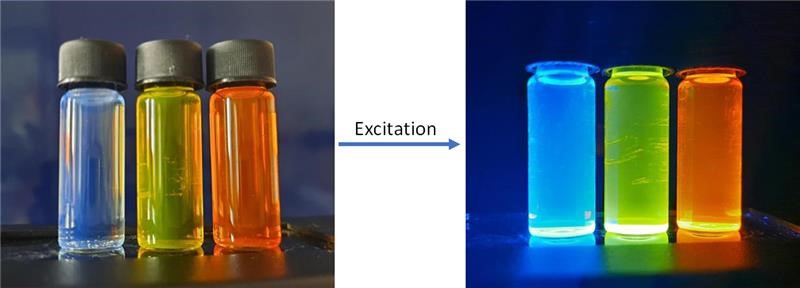
– organic dyes, with specific optical properties (e.g. defined spectral regions of absorption and emission) and physicochemical properties (e.g. thermal stability), which can be obtained both by modifying known molecules and by synthesizing new chemical structures. In addition, the Group has knowledge of long-luminescent materials (so-called “glowing in the dark”), the principle of action is to release previously absorbed energy from visible or UV radiation after switching off the light source. We are also interested in biologically active organic compounds with antioxidant, antimicrobial and anticancer properties.
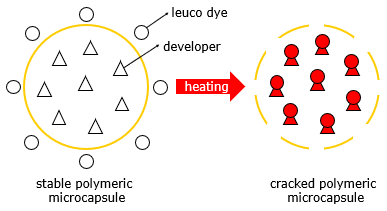 – thermochromic materials, i.e. those that change their color in a reversible or irreversible way after exceeding a certain temperature. The color change may result from the polymerization of reactive monomers, the formation of a leuco dye – developer complex, or the formation of a complex between an organic ligand and a transition metal ion. Materials with a reversible color change can be used as thermometers to provide information on the current temperature. On the other hand, materials with an irreversible color change can be used as indicators of a single exposure to too low or too high temperature.
– thermochromic materials, i.e. those that change their color in a reversible or irreversible way after exceeding a certain temperature. The color change may result from the polymerization of reactive monomers, the formation of a leuco dye – developer complex, or the formation of a complex between an organic ligand and a transition metal ion. Materials with a reversible color change can be used as thermometers to provide information on the current temperature. On the other hand, materials with an irreversible color change can be used as indicators of a single exposure to too low or too high temperature.
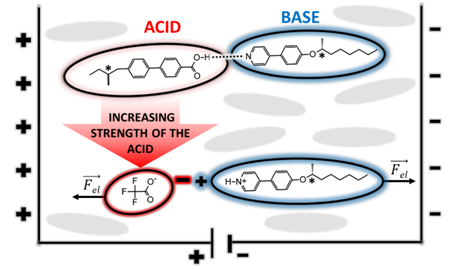 – liquid crystalline systems doped with chiral organic salts, in which electrically-induced transport of chiral ionic dopant inside a cell is expected. Goal of the research is induction of local concentration gradient along the depth of the cell, and in the result broadening of the selective light reflection band. The effect may be applied in electrically-driven mirrors and reflective displays. It was found, that in chiral liquid crystalline systems, composed of acid-base pairs, the hydrogen or ionic bond is being formed, depending on the pKadifference between the acid and base.
– liquid crystalline systems doped with chiral organic salts, in which electrically-induced transport of chiral ionic dopant inside a cell is expected. Goal of the research is induction of local concentration gradient along the depth of the cell, and in the result broadening of the selective light reflection band. The effect may be applied in electrically-driven mirrors and reflective displays. It was found, that in chiral liquid crystalline systems, composed of acid-base pairs, the hydrogen or ionic bond is being formed, depending on the pKadifference between the acid and base.
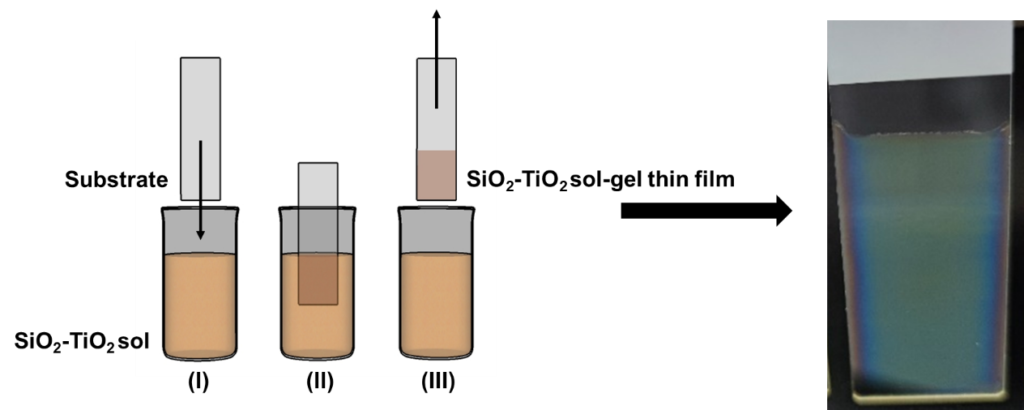 – preparation and characterization of films with controlled refractive index value, in particular materials synthesized using sol-gel processes and polymeric materials. The aim is to optimize the process of production of films with an appropriate refractive index and thickness, which may enable the use of such materials in integrated optics systems, among others as waveguide layers. The thin films may also be a matrix for luminescent organic dyes.
– preparation and characterization of films with controlled refractive index value, in particular materials synthesized using sol-gel processes and polymeric materials. The aim is to optimize the process of production of films with an appropriate refractive index and thickness, which may enable the use of such materials in integrated optics systems, among others as waveguide layers. The thin films may also be a matrix for luminescent organic dyes.
– fabrication methods of periodic micro- and nanostructures, in particular fabrication of photonic crystals (opals and inversed opals) by synthethic methods and optical holography, e.g. inscription of Surface Relief Gratings (SRG) in azopolymers. Periodic structures may be characterized by such optical properties, as: diffraction, selective light reflection (Bragg reflection). They may be applied among other as light couplers for waveguides, distributed feedback resonator systems for laser action and element of sensors, based on optical properties of the materials.
- AFM image of holographic surface relief grating in
- SEM image of PMMA opal
- SEM image of SiO2 inversed opal
– micro- and nanostructuring of materials using electron beam. Materials can be modified and, at the same time, patterned with high precision in micro- and nanoscale by selective exposure to the focused electron beam. In this context, ionic liquids are particularly interesting materials as they have unique combination of physicochemical properties such as negligible volatility, ionic conductivity, high thermal and chemical stability. The potential applications of the developed method of electron beam patterning include, for example, fabrication of planar photonic components and new resists for e-beam lithography.

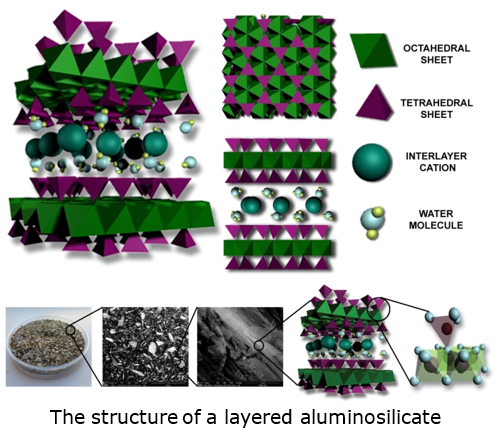 – porous layered materials, especially aluminosilicates and double hydroxides. Such have special structure giving them unique chemical and physical characteristics that can be modified in order to change their properties and tune the materials according to the application field. The principal interest areas include the synthesis and modifications of materials for the use in adsorption from water and air, catalysis, and functional composite materials production.
– porous layered materials, especially aluminosilicates and double hydroxides. Such have special structure giving them unique chemical and physical characteristics that can be modified in order to change their properties and tune the materials according to the application field. The principal interest areas include the synthesis and modifications of materials for the use in adsorption from water and air, catalysis, and functional composite materials production.

System for the synthesis of graphene/ dichalcogenides
– two-dimensional materials, i.e. those with a thickness of one or more atomic layers. These materials have specific electronic and optical properties compared with their three-dimensional counterparts. The Group is particularly interested in the synthesis, transfer and studies on the properties of graphene and dichalcogenides. Graphene, in addition to its excellent electrical properties, also has properties that allow it to be used as an anti-corrosion layer in microelectronic, interconnects or implantable devices. Graphene coatings are highly impermeable to all gases, liquids and aggressive chemicals.Transition metal dichalcogenides (TMDCs) for years have attracted great interest in research due to their unique properties such as direct band gap comparing to their bulk samples. Semiconducting TMDCs based on molybdenum and tungsten with band gaps ranging from the visible to the near infra-red possess great application possibilities in flexible electronics, optoelectronics or as nanoscale semiconductors.
On-going implementation doctorates:
Andrii Bodnar, M.Sc., Eng. (2nd year Ph.D. student)
Topic: “Development of technology for ohmic and Schottky contacts formation for selected van der Waals crystals”
Doctorate realized in cooperation with the Doctoral School of the Wrocław University of Science and Technology.
Supervisor: Prof. Robert Kudrawiec, D.Sc., Ph.D., Eng.
Łukasz Duda, M.Sc., Eng. (2nd year Ph.D. student)
Topic: ”Organic dyes for application in photonics”
Doctorate realized in cooperation with the Doctoral School of the University of Wrocław – the Doctoral College of Chemistry.
Supervisor: MałgorzataGuzik, D.Sc., Ph.D.
Auxiliary Supervisor: Maciej Czajkowski, Ph.D., Eng.
Maria Zdończyk, M.Sc. (2nd year Ph.D. student)
Topic: „Luminescent active layers for hybrid platforms”
Doctorate realized in cooperation with the Doctoral School of the University of Wrocław – the Doctoral College of Chemistry.
Supervisor: Joanna Cybińska, D.Sc., Ph.D.
Auxiliary Supervisor: Bartłomiej Potaniec, Ph.D., Eng.
Krzysztof Lis, M.Sc., Eng. (3rd year Ph.D. student)
Topic: “Development of technology for coating copper tracks and wires with graphene layers for applications in electronics”
Doctorate realized in cooperation with the Doctoral School of the Wrocław University of Science and Technology.
Supervisor: Prof. GrażynaGryglewicz, D.Sc., Ph.D., Eng.
Supervisor: AlicjaBachmatiuk, D.Sc., Ph.D., Eng.
On-going projects:
1. “Two dimensional Van der Waals crystals on nitride semiconductors – optimalization of the Shottky barrier for UV detection” (project acronym: Van der GaN)
Project financed by the special-purpose subvention of the Łukasiewicz Research Network for 2021
Total cost: 1 227 916,00 PLN
Duration: 10/08/2021 – 09/08/2023
Principal Investigator: Jean-Guy Rousset, Ph.D.
2. “Development of a technology for the carbonization of organic raw materials using microwave techniques to implement an innovative active carbon production process” (project acronym: ActivC)
Project financed under the Regional Operational Program of the Lower Silesian Voivodship 2014 – 2020 from the European Union, the European Regional Development Fund
Total cost: 2 625 369,50 PLN
Duration: 01/05/2021 – 30/04/2023
Project realized in a consortium:
- Usagi Ltd. – Consortium Leader
- Łukasiewicz Research Network – PORT Polish Center for Technology Development
Principal Investigator (on the site of Łukasiewicz – PORT): Krzysztof Lis, M.Sc., Eng.
3. “Thermochromic indicator of deep-freezing exit” (project acronym: INDICATOR)
Project financed by the National Centre for Research and Development under the “Lider XI” program
Total cost: 1 493 815,00 PLN
Duration: 01/01/2021 – 01/01/2024
Principal Investigator: Magdalena Wilk-Kozubek, Ph.D, Eng.
https://www.port.lukasiewicz.gov.pl/pl/projekt/indicator/

4. “2D MXenes based anode materials for all-solid-state Li-ion batteries” (project acronym: 2D-SSB)
Project financed by the Norwegian Financial Mechanism for 2014 – 2021 under the GRIEG program
Total cost: 6 365 125,00 PLN
Duration: 02/10/2020 – 01/10/2023
Project realized in a consortium:
- Łukasiewicz Research Network – PORT Polish Center for Technology Development – Consortium Leader
- University of Oslo
- SINTEF
Principal Investigator: Alicja Bachmatiuk, D.Sc., Ph.D., Eng.
https://www.port.lukasiewicz.gov.pl/en/projekt/norway-grants/
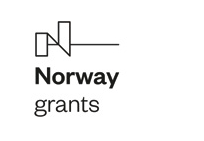
5. “Hybrid sensor platforms of integrated photonic systems based on ceramic and polymer materials” (project acronym: HYPHa)
Project financed by the European Union from the European Regional Development Fund under the TEAM-NET program of the Foundation for Polish Science
Total cost: 13 208 000,00 PLN
Total cost (on the side of Łukasiewicz – PORT): 3 499 250,00 PLN
Duration: 24/10/2019 – 29/12/2022
Project realized in a consortium:
- Łukasiewicz Research Network – PORT Polish Center for Technology Development – Consortium Leader
- Wrocław University of Science and Technology
- Silesian University of Technology
- Warsaw University of Technology
Principal Investigator: Alicja Bachmatiuk, D.Sc., Ph.D., Eng.
Group Leader (on the side of Łukasiewicz – PORT): Małgorzata Guzik, D.Sc., Ph.D.
https://www.port.lukasiewicz.gov.pl/pl/projekt/hypha/

6. “Liquid crystalline systems as sources of electrically tunable laser white light” (project acronym: White Lasing)
Project financed by the National Science Centre, Poland under the “OPUS 16” program.
Total cost: 1 406 000,00 PLN
Total cost (on the side of Łukasiewicz – PORT): 688 800,00 PLN
Duration: 08/07/2019 – 07/07/2022
Project realized in a consortium:
- Wrocław University of Science and Technology – Consortium Leader
- Łukasiewicz Research Network – PORT Polish Center for Technology Development
Principal Investigator: Jarosław Myśliwiec, D.Sc., Ph.D., Eng.
Principal Investigator (on the side of Łukasiewicz – PORT): Joanna Cybińska, D.Sc., Ph.D.
https://www.port.lukasiewicz.gov.pl/pl/projekt/white-lasing/

7. “Technology development for the production of passive anti-icing systems based on innovative superhydrophobic epoxy nanocomposite coatings” (project acronym: ICE)
Project financed by the National Centre for Research and Development under the “Lider IX” program
Total cost: 1 199 825,00 PLN
Duration: 01/01/2019 – 31/12/2021
Principal Investigator: Jacek Marczak, Ph.D.
https://port.lukasiewicz.gov.pl/projekt/ice/

Completed projects:
1. “Design and preparation of heterometallic molecular clusters. Studies of their catalytic properties and transformation to novel nanomaterials” (project acronym: Klastery)
Project financed by the National Science Centre, Poland under the “OPUS 15” program
Total cost: 1 462 800, 00 PLN
Duration: 21/03/2019 – 30/04/2021
Principal Investigator: Prof. Piotr Ludwik Sobota, D.Sc., Ph.D.
https://www.port.lukasiewicz.gov.pl/pl/projekt/klastery/

2. “Development of innovative technology for personalization of polycarbonate blanks for government documents” (project acronym: LaserMark)
Project financed by the National Centre for Research and Development under the 8/2016 program
Total cost: 7 850 000,00 PLN
Total cost (on the side of Łukasiewicz – PORT): 3 499 625,00 PLN
Duration: 15/12/2016 – 14/12/2020
Project realized in a consortium:
- Polish Security Printing Works – Consortium Leader
- Wrocław Research Centre EIT+
Principal Investigator (on the side of WRC EIT+): Tomasz Baraniecki, Ph.D., Eng.
https://www.port.lukasiewicz.gov.pl/pl/projekt/lasermark/

3. “Fabrication and characteristics of new liquid-crystalline materials comprising chiral ionic compounds for application in light modulators” (project acronym: CILC)
Project financed by the National Science Centre, Poland under the „SONATA 11” program
Total cost: 278 800,00 PLN
Duration: 20/01/2017 – 19/01/2020
Principal Investigator: Maciej Czajkowski, Ph.D., Eng.
https://www.port.lukasiewicz.gov.pl/pl/projekt/cilc/

4. “Fabrication and optimization of photonic components by electron and ion beam induced polymerization of ionic liquid monomers” (project acronym: FACILE)
Project financed by the National Science Centre, Poland under the „OPUS 10” program
Total cost: 1 326 700,00 PLN
Total cost (on the side of Łukasiewicz – PORT): 624 200,00 PLN
Duration: 24/10/2016 – 23/04/2020
Project realized in a consortium:
- Wrocław Research Centre EIT+ – Consortium Leader
- Adam Mickiewicz University Foundation
Principal Investigator: Katarzyna Komorowska, Ph.D., Eng.
https://www.port.lukasiewicz.gov.pl/pl/projekt/facile/

5. ”Synthesis of new chemiluminescent compounds for two components, ecologically friendly glowing sticks” (project acronym: GLOW)
Project financed from statutory subvention of the Ministry of Science and Higher Education for 2018
Total cost: 108 800,00 PLN
Duration: 03/12/2018 – 15/12/2019
Principal Investigator: Marcin Skoreński, Ph.D., Eng.
6. “Polymer composites with the fungicidal and bactericidal properties for use in furniture industry” (project acronym: AntiBac)
Project financed from statutory subvention of the Ministry of Science and Higher Education for 2018
Total cost: 140 400,00 PLN
Duration: 03/12/2018 – 13/12/2019
Principal Investigator: Marta Fiedot-Toboła, Ph.D., Eng.
2021
1. Duda, Ł.; Potaniec, B.; Czajkowski, M.; Fiedot-Toboła, M.; Palewicz, M.; Zdończyk, M.; Madej, A.; Cybińska, J. Studies of intermolecular proton transfer, its influence on the liquid crystal properties and electrically-driven transport of chiral ions in mixtures of chiral liquid crystalline 4-phenylpyridine derivative and organic acids of various strength. J. Mol. Liq. 2021, 336, art. no. 116455. DOI: 10.1016/j.molliq.2021.116455
2. Fiedot-Toboła, M.; Dmochowska, A.; Jędrzejewski, R.; Stawiński, W.; Kryszak, B.; Cybińska, J. Pectin-organophilized ZnO nanoparticles as sustainable fillers for high-density polyethylene composites. Int. J. Biol. Macromol. 2021, 182, 1832–1842. DOI: 10.1016/j.ijbiomac.2021.05.133
3. Fiedot-Toboła, M.; Dmochowska, A.; Potaniec, B.; Czajkowska, J.; Jędrzejewski, R.; Wilk-Kozubek, M.; Carolak, E.; Cybińska, J. Gallic Acid Based Black Tea Extract as a Stabilizing Agent in ZnO Particles Green Synthesis. Nanomaterials, 2021, 11 (7), art. no. 1816. DOI: 10.3390/nano11071816
4. Kowal, D.; Rola, K.; Cybinska, J.; Skorenski, M.; Zajac, A.; Szpecht, A.; Smiglak, M.; Drobczynski, S.; Ciesiolkiewicz, K.; Komorowska, K. Fluorescent ionic liquid micro reservoirs fabricated by dual-step E-beam patterning. Mater. Res. Bull. 2021, 142, art. no. 111434. DOI: 10.1016/j.materresbull.2021.111434
5. Pawłów, J.; Prokop, K.A.; Guzik, M.; Guyot, Y.; Boulon, G.; Cybińska, J. Nano/micro -powders of Nd3+-doped YPO4 and LuPO4 under structural and spectroscopic studies. An abnormal temporal behavior of f-f photoluminescence. J. Lumin. 2021, 236, art. no. 117997. DOI: 10.1016/j.jlumin.2021.117997
6. Podstawczyk, D.; Nizioł, M.; Szymczyk-Ziółkowska, P.; Fiedot-Toboła, M. Development of Thermoinks for 4D Direct Printing of Temperature-Induced Self-Rolling Hydrogel Actuators. Adv. Funct. Mater. 2021, 31 (15), art. no. 2009664. DOI: 10.1002/adfm.202009664
7. Rola, K.; Zając A.; Szpecht A.; Kowal D.; Cybińska J.; Śmiglak M.; Komorowska K. Interaction of electron beam with ionic liquids and its application for micropatterning. Eur. Polym. J. 2021, 156, art. no. 110615. DOI: 10.1016/j.eurpolymj.2021.110615
8. Stawiński, W.; Wal, K.; Rutkowski, P. Microbial Degradation of Polymers, Recent Advances, in: Microbial Degradation; Inamuddin; Ahmed, M.I.; Prasad, R., Eds.; Springer, 19–46, 2021. DOI: 10.1007/978-981-16-0518-5_2
2020
9. Babizhetskyy, V.; Levytskyy, V.; Smetana, V.; Wilk-Kozubek, M.; Tsisar, O.; Piskach, L.; Parasyuk, O.; Mudring, A.-V. New cation-disordered quaternary selenides Tl2Ga2TtSe6 (Tt=Ge, Sn). Z. Naturforsch. Sect. B J. Chem. Sci. 2020, 75 (1), 135–142. DOI: 10.1515/znb-2019-0169
10. Bastrzyk, A.; Fiedot-Toboła, M.; Maniak, H.; Polowczyk, I.; Płaza, G. Surfactin as a green agent controlling the growth of porous calcite microstructures. Int. J. Mol. Sci. 2020, 21 (15), art. no. 5526, 1–15. DOI: 10.3390/ijms21155526
11. Dmochowska, A.; Czajkowska, J.; Jędrzejewski, R.; Stawiński, W.; Migdał, P.; Fiedot-Toboła, M. Pectin based banana peel extract as a stabilizing agent in zinc oxide nanoparticles synthesis. Int. J. Biol. Macromol. 2020, 165, 1581–1592. DOI: 10.1016/j.ijbiomac.2020.10.042
12. Fiedot-Toboła, M.; Suchorska-Woźniak, P.; Startek, K.; Rac-Rumijowska, O.; Szukiewicz, R.; Kwoka, M.; Teterycz, H. Correlation between microstructure and chemical composition of zinc oxide gas sensor layers and their gas-sensitive properties in chlorine atmosphere. Sensors (Switzerland), 2020, 20 (23), art. no. 6951, 1–17. DOI: 10.3390/s20236951
13. Frydrych, R.; Lis, T.; Bury, W.; Cybińska, J.; Stȩpień, M. Feeding a Molecular Squid: A Pliable Nanocarbon Receptor for Electron-Poor Aromatics. J. Am. Chem. Soc. 2020, 142 (36), 15604–15613. DOI: 10.1021/jacs.0c07956
14. Juraszek, J.; Rola, K.; Daszkiewicz, M.; Samsel-Czekała, M.; Cichorek, T.; Henkie, Z. Crystal growth, low-temperature specific heat, and electronic structure of the filled skutterudite compound ThOs4As12. Philos. Mag. 2020, 100 (10), 1355–1366. DOI: 10.1080/14786435.2020.1727037
15. Kozłowska, J.; Potaniec, B.; Anioł, M. Biotransformation of hydroxychalcones as a method of obtaining novel and unpredictable products using whole cells of bacteria. Catalysts, 2020, 10 (10), art. no. 1167, 1–11. DOI: 10.3390/catal10101167
16. Kumar, S.; Maurya, Y.K.; Kang, S.; Chmielewski, P.; Lis, T.; Cybińska, J.; Kim, D.; Stȩpień, M. Porphyrin-Ryleneimide Hybrids: Tuning of Visible and Near-Infrared Absorption by Chromophore Desymmetrization. Org. Lett. 2020, 22 (18), 7202–7207. DOI: 10.1021/acs.orglett.0c02544
17. Moshniaha, L.; Żyła-Karwowska, M.; Chmielewski, P.J.; Lis, T.; Cybińska, J.; Gońka, E.; Oschwald, J.; Drewello, T.; Rivero, S.M.; Casado, J.; Stȩpień, M. Aromatic Nanosandwich Obtained by σ-Dimerization of a Nanographenoid π-Radical. J. Am. Chem. Soc. 2020, 142 (7), 3626–3635. DOI: 10.1021/jacs.9b13942
18. Petrus, R.; Chomiak, K.; Utko, J.; Wilk-Kozubek, M.; Lis, T.; Cybińska, J.; Sobota, P. Convenient Route to Heterometallic Group 4-Zinc Precursors for Binary Oxide Nanomaterials. Inorg. Chem. 2020, 59 (12), 8108–8120. DOI: 10.1021/acs.inorgchem.0c00399
19. Renier, O.; Bousrez, G.; Stappert, K.; Wilk-Kozubek, M.; Adranno, B.; Pei, H.; Spielberg, E.T.; Smetana, V.; Mudring, A.-V. Photoisomerization and Mesophase Formation in Azo-Ionic Liquids. Cryst. Growth Des. 2020, 20 (1), 214–225. DOI: 10.1021/acs.cgd.9b01018
20. Stawiński, W. Green Solvents for Environmental Remediation, in: Liquid Polymers for Environmental Remediation; Inamuddin; Boddula, R.; Assiri, A., Eds.; Elsevier, 67–88, 2020. DOI: 10.1016/B978-0-12-821884-6.00010-3
21. Wal, K.; Stawiński, W.; Dmochowska, A. Maleic Anhydride Antimicrobial Polymers, in: Advanced Antimicrobial Materials and Applications; Inamuddin; Ahmed, M.I.; Prasad, R., Eds.; Springer, 171–192, 2020. DOI: 10.1007/978-981-15-7098-8_7
2019
22. Abdelhamid, H.N.; Wilk-Kozubek, M.; El-Zohry, A.M.; Bermejo Gómez, A.; Valiente, A.; Martín-Matute, B.; Mudring, A.-V.; Zou, X. Luminescence properties of a family of lanthanide metal-organic frameworks. Microporous Mesoporous Mater. 2019, 279, 400–406. DOI: 10.1016/j.micromeso.2019.01.024
23. Bastrzyk, A.; Fiedot-Toboła, M.; Polowczyk, I.; Legawiec, K.; Płaza, G. Effect of a lipopeptide biosurfactant on the precipitation of calcium carbonate. Colloids Surf. B: Biointerfaces, 2019, 174, 145–152. DOI: 10.1016/j.colsurfb.2018.11.009
24. Bukowczan, A.; Hebda, E.; Czajkowski, M.; Pielichowski, K. The synthesis and properties of liquid crystalline polyurethanes, chemically modified by polyhedral oligomericsilsesquioxanes. Molecules, 2019, 24 (22), art. no. 4013. DOI: 10.3390/molecules24224013
25. Chand, D.; Wilk-Kozubek, M.; Smetana, V.; Mudring, A.-V. Alternative to the Popular Imidazolium Ionic Liquids: 1,2,4-Triazolium Ionic Liquids with Enhanced Thermal and Chemical Stability. ACS Sustainable Chem. Eng. 2019, 7 (19), 15995–16006. DOI: 10.1021/acssuschemeng.9b02437
26. Duda, Ł.; Czajkowski, M.; Potaniec, B.; Vaňkátová, P. Helical twisting power and compatibility in twisted nematic phase of new chiral liquid crystalline dopants with various liquid crystalline matrices. Liq. Cryst. 2019, 46 (12), 1769–1779. DOI: 10.1080/02678292.2019.1599454
27. Karbownik, I.; Rac-Rumijowska, O.; Fiedot-Toboła, M.; Rybicki, T.; Teterycz, H. The preparation and characterization of polyacrylonitrile-polyaniline (PAN/PANI) fibers. Mater. 2019, 12 (4), art. no. 664. DOI: 10.3390/ma12040664
28. Kozłowska, J.; Potaniec, B.; Baczyńska, D.; Zarowska, B.; Anioł, M. Synthesis and biological evaluation of novel aminochalcones as potential anticancer and antimicrobial agents. Molecules, 2019, 24 (22), art. no. 4129. DOI: 10.3390/molecules24224129
29. Navakouski, M.; Zhylitskaya, H.; Chmielewski, P.J.; Lis, T.; Cybińska, J.; Stępień, M. Stereocontrolled Synthesis of Chiral Heteroaromatic Propellers with Small Optical Bandgaps. Angew. Chem. Int. Ed. 2019, 58 (15), 4929–4933. DOI: 10.1002/anie.201900175
30. Rac-Rumijowska, O.; Maliszewska, I.; Fiedot-Toboła, M.; Karbownik, I.; Teterycz, H. Multifunctional nanocomposite cellulose fibers doped in situ with silver nanoparticles. Polym. 2019, 11 (3), art. no. 562. DOI: 10.3390/polym11030562
31. Rola, K.; Zajac, A.; Cybińska, J.; Smiglak, M.; Komorowska, K. Polymerizable ionic liquids for microstructures fabrication. Proc. SPIE Int. Soc. Opt. Eng. 2019, 10915, art. no. 109151E. DOI: 10.1117/12.2509680
32. Rola, K.; Zajac, A.; Czajkowski, M.; Fiedot-Tobola, M.; Szpecht, A.; Cybinska, J.; Smiglak, M.; Komorowska, K. Electron Beam Patterning of Polymerizable Ionic Liquid Films for Application in Photonics. Langmuir, 2019, 35 (37), 11968–11978. DOI: 10.1021/acs.langmuir.9b00759
33. Rola, K.; Zając, A.; Czajkowski, M.; Szpecht, A.; Zdończyk, M.; Śmiglak, M.; Cybińska, J.; Komorowska, K. Ionic liquids for active photonics components fabrication. Opt. Mater. 2019, 89, 106–111. DOI: 10.1016/j.optmat.2019.01.003
34. Senthilkumar, K.; Kondratowicz, M.; Lis, T.; Chmielewski, P.J.; Cybińska, J.; Zafra, J.L.; Casado, J.; Vives, T.; Crassous, J.; Favereau, L.; Stȩpień, M. Lemniscular [16]Cycloparaphenylene: A Radially Conjugated Figure-Eight Aromatic Molecule. J. Am. Chem. Soc. 2019, 141 (18), 7421–7427. DOI: 10.1021/jacs.9b01797
35. Silva, A.; Stawiński, W.; Romacho, J.; Santos, L.H.M.L.M.; Figueiredo, S.A.; Freitas, O.M.; Delerue-Matos, C. Adsorption of Fluoxetine and Venlafaxine onto the Marine Seaweed Bifurcaria bifurcate. Environ. Eng. Sci. 2019, 36 (5), 573–582. DOI: 10.1089/ees.2018.0332
36. Smetana, V.; Wilk-Kozubek, M.; Mudring, A.-V. Active-Transition-Metal Tellurides: Through Crystal Structures to Physical Properties. Cryst. Growth Des. 2019, 19 (9), 5429–5440. DOI: 10.1021/acs.cgd.8b01582
37. Wang, G.; Valldor, M.; Dorn, K.V.; Wilk-Kozubek, M.; Smetana, V.; Mudring, A.-V. Ionothermal Synthesis Enables Access to 3D Open Framework Manganese Phosphates Containing Extra-Large 18-Ring Channels. Chem. Mater. 2019, 31 (18), 7329–7339. DOI: 10.1021/acs.chemmater.9b01935
38. Wang, G.; Valldor, M.; Siebeneichler, S.; Wilk-Kozubek, M.; Smetana, V.; Mudring, A.-V. Ionothermal Synthesis, Structures, and Magnetism of Three New Open Framework Iron Halide-Phosphates. Inorg. Chem. 2019, 58 (19), 13203–13212. DOI: 10.1021/acs.inorgchem.9b02028
39. Zajac, A.; Szpecht, A.; Zielinski, D.; Rola, K.; Hoppe, J.; Komorowska, K.; Smiglak, M. Synthesis and characterization of potentially polymerizable amine-derived ionic liquids bearing 4-vinylbenzyl group. J. Mol. Liq. 2019, 283, 427–439. DOI: 10.1016/j.molliq.2019.03.061
2018
40. Prodius, D., Wilk-Kozubek, M., Mudring, A.-V. Synthesis, structural characterization and luminescence properties of 1-carboxymethyl-3-ethylimidazolium chloride. Acta Crystallogr., C Struct. Chem. 2018, 74, 653–658. DOI: 10.1107/S2053229618005272
41. Rac-Rumijowska, O.; Fiedot-Tobola, M.; Karbownik, I.; Teterycz, H. Influence of Bulk Silver Nanoparticles on Surface Layer Properties in Nanocomposite Cellulose Fibers. Proc. Int. Spring Semin. Electron. Technol. 2018, art. no. 8443676. DOI: 10.1109/ISSE.2018.8443676
42. Rola, K.; Zajac, A.; Czajkowski, M.; Cybinska, J.; Martynkien, T.; Smiglak, M.; Komorowska, K. Ionic liquids – A novel material for planar photonics. Nanotechnology, 2018, 29 (47), art. no. 475202. DOI: 10.1088/1361-6528/aae01e
43. Zeler, J.; Cybińska, J.; Zych, E. Luminescence properties of translucent nano- and micro-crystalline LuPO4:Ce3+ films in the 20–700 K range of temperatures. J. Lumin. 2018, 200, 50–58. DOI: 10.1016/j.jlumin.2018.04.008
44. Żyła-Karwowska, M.; Moshniaha, L.; Hong, Y.; Zhylitskaya, H.; Cybińska, J.; Chmielewski, P.J.; Lis, T.; Kim, D.; Stępień, M. Electron-Deficient Bipyrrole Boomerangs: Bright Fluorophores Obtained via Double C−H Bond Activation. Chem. Eur. J. 2018, 24 (29), 7525–7530. DOI: 10.1002/chem.201801199
2017
45. Cybinska, J.; Guzik, M.; Lorbeer, C.; Zych, E.; Guyot, Y.; Boulon, G.; Mudring, A.-V. Design of LaPO4:Nd3+ materials by using ionic liquids. Opt. Mater. 2017, 63, 76–87. DOI: 10.1016/j.optmat.2016.09.025
46. Cybinska, J.; Lorbeer, C.; Zych, E.; Mudring, A.-V. Ionic liquid supported synthesis of nano-sized rare earth doped phosphates. J. Lumin. 2017, 189, 99–112. DOI: 10.1016/j.jlumin.2017.02.033
47. Czajkowski, M.; Klajn, J.; Cybińska, J.; Feder-Kubis, J.; Komorowska, K. Cholesteric gratings induced by electric field in mixtures of liquid crystal and novel chiral ionic liquid. Liq. Cryst. 2017, 44 (5), 911–923. DOI: 10.1080/02678292.2016.1254825
48. Li, M.; Smetana, V.; Wilk-Kozubek, M.; Mudryk, Y.; Alammar, T.; Pecharsky, V.K.; Mudring, A.-V. Open-Framework Manganese(II) and Cobalt(II) Borophosphates with Helical Chains: Structures, Magnetic, and Luminescent Properties. Inorg. Chem. 2017, 56 (18), 11104–11112. DOI: 10.1021/acs.inorgchem.7b01423
49. Prodius, D.; Smetana, V.; Steinberg, S.; Wilk-Kozubek, M.; Mudryk, Y.; Pecharsky, V.K.; Mudring, A.-V. Breaking the paradigm: record quindecim charged magnetic ionic liquids. Mater. Horiz. 2017, 4, 217–221. DOI: 10.1039/c6mh00468g
50. Wilk-Kozubek, M.; Jarzembska, K.N.; Janczak, J.; Videnova-Adrabinska, V. Synthesis, structural characterization and computational studies of catena-poly[chlorido[μ3-(pyridin-1-ium-3-yl)phosphonato-κ3O:O′:O′′]zinc(II)]. Acta Crystallogr., C Struct. Chem. 2017, 73 (5), 363–368. DOI: 10.1107/S2053229617004478
2016
51. Cybińska, J.; Woźniak, M.; Mudring, A.-V.; Zych, E. Controllable synthesis of nanoscale YPO4:Eu3+ in ionic liquid. J. Lumin. 2016, 169, 868–873. DOI: 10.1016/j.jlumin.2015.07.008
52. Czajkowski, M.; Cybińska, J.; Woźniak, M.; Słupski, P.; Nikodem, M.; Granek, F.; Komorowska, K. Incorporation of luminescent semiconductor nanoparticles into liquid crystal matrix. J. Lumin. 2016, 169, 850–856. DOI: 10.1016/j.jlumin.2015.08.011
53. Zeler, J.; Cybińska, J.; Zych, E. A new photoluminescent feature in LuPO4:Eu thermoluminescent sintered materials. RSC Adv. 2016, 6 (63), 57920–57928. DOI: 10.1039/c6ra09588g
54. Zhylitskaya, H.; Cybińska, J.; Chmielewski, P.; Lis, T.; Stȩpień, M. Bandgap Engineering in π-Extended Pyrroles. A Modular Approach to Electron-Deficient Chromophores with Multi-Redox Activity. J. Am. Chem. Soc. 2016, 138 (35), 11390–11398. DOI: 10.1021/jacs.6b07826
55. Zych, E.; Kulesza, D.; Zeler, J.; Cybińska, J.; Fiaczyk, K.; Wiatrowska, A. SrS:Ce and LuPO4:Eu sintered ceramics: Old phosphors with new functionalities. ECS J. Solid State Sci. Technol. 2016, 5 (1), R3078–R3088. DOI: 10.1149/2.0101601jss
56. Zyła, M.; Gońka, E.; Chmielewski, P.J.; Cybińska, J.; Stępień, M. Synthesis of a peripherally conjugated 5-6-7 nanographene. Chem. Sci. 2016, 7 (1), 286–294. DOI: 10.1039/c5sc03280f
57. Żyła-Karwowska, M.; Zhylitskaya, H.; Cybińska, J.; Lis, T.; Chmielewski, P.J.; Stępień, M. An Electron-Deficient Azacoronene Obtained by Radial π Extension. Angew. Chem. Int. Ed. 2016, 55 (47), 14658–14662. DOI: 10.1002/anie.201608400
Małgorzata Guzik, D.Sc., Ph.D.
- Outgoing scholarship within the Bekker Program 2020, awarded by the Polish National Agency for Academic Exchange (NAWA)
Maciej Czajkowski, Ph.D., Eng.
- 2nd prize for the best Ph.D. Thesis in the field of Liquid Crystals within time range from 16.07.2014 to 15.07.2016, awarded by the Polish Liquid Crystal Society
Bartłomiej Potaniec, Ph.D., Eng.
- Gold medal in the contest “International Warsaw Invention Show IWIS 2019”, organised by the Association of Polish Inventors and Rationalizers, Warsaw, 16th October 2019
- Distinction in the 9th edition of the national contest “Student-Inventor“, organised by the Kielce University of Technology, 6th February 2019
Łukasz Duda, M.Sc., Eng.
- Scholarship of the Rector of Wrocław University of Science and Technology for high grade point average and achievements, granted in winter semester 2018/2019, summer semester 2018/2019 and winter semester 2019/2020
- Scholarship from own scholarship fund of Wrocław University of Science and Technology for academic achievements, granted in the summer semester 2018/2019
- 8th place in the ranking of the 10 best graduates of Master’s studies at the Faculty of Chemistry of the Wrocław University of Science and Technology in the academic year 2019/2020
Maria Zdończyk, M.Sc.
- Scholarship of the Minister of Science and Higher Education for students for outstanding scientific achievements (granted in the academic year 2019/2020),
- University of Wrocław Rector’s scholarship for students for outstanding scientific achievements in the academic year 2019/2020.
Kacper Prokop, M.Sc.
- Laureate of the national contest “Student Nobel 2021”, organised by the Independent Students’ Association in the category of Life Sciences and Energy, Warsaw, Poland, 2021
- Scholarship of the Minister of Science and Higher Education for students for outstanding scientific achievements (granted in the academic year 2020/2021)
- University of Wrocław Rector’s scholarship for students for outstanding scientific achievements in the academic year 2019/2020 and 2020/2021
- Finalist of the national contest “Gold Medal of Chemistry”, organised by the Institute of Physical Chemistry PAS for the best bachelor’s thesis in chemistry, Warsaw, Poland, 2019


